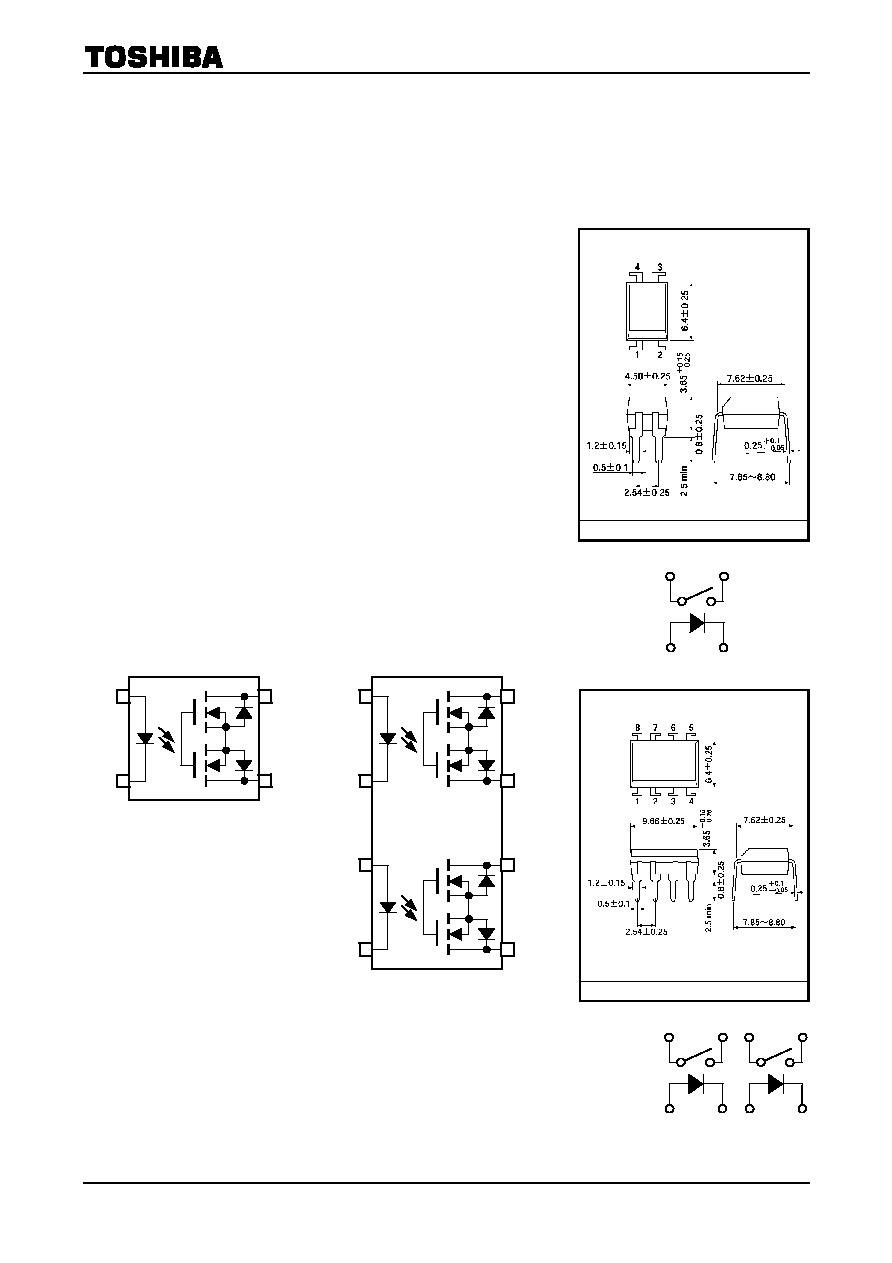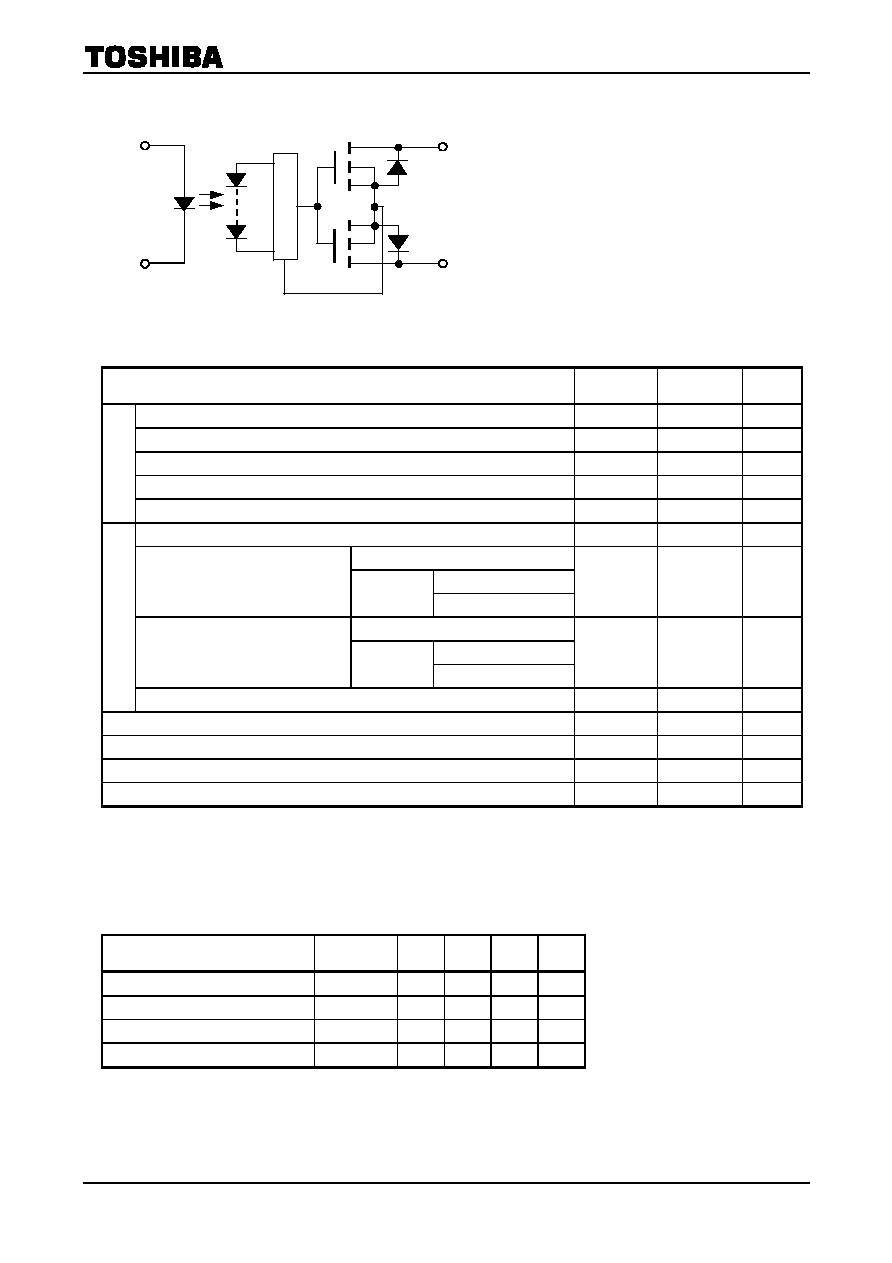 | ÐлекÑÑоннÑй компоненÑ: TLP227G-2 | СкаÑаÑÑ:  PDF PDF  ZIP ZIP |
Äîêóìåíòàöèÿ è îïèñàíèÿ www.docs.chipfind.ru

TLP227G(N),TLP227G-2(N)
2003-01-28
1
TOSHIBA PHOTOCOUPLER PHOTO RELAY
TLP227G(N),TLP227G-2(N)
CORDLESS TELEPHONE
PBX
MODEM
The TOSHIBA TLP227G series consist of a gallium arsenide infrared
emitting diode optically coupled to a photo-MOS FET in a plastic DIP
package.
The TLP227G series are a bi-directional switch, which can replace
mechanical relays in many applications.
FEATURES
· TLP227G
: 4 pin DIP (DIP4), 1 Channel Type (1 Form A)
· TLP227G-2
: 8 pin DIP (DIP8), 2 Channel Type (2 Form A)
· Peak Off-State Voltage : 350 V (MIN.)
· Trigger LED Current : 3 mA (MAX.)
· On-State Current
: 120 mA (MAX.)
· On-State Resistance
: 25 (MAX.)
· Isolation Voltage
: 2500 Vrms (MIN.)
PIN CONFIGURATION (TOP VIEW)
TLP227G
TLP227G-2
1 : ANODE
2 : CATHODE
3 : DRAIN
4 : DRAIN
1, 3 : ANODE
2, 4 : CATHODE
5 : DRAIN D1
6 : DRAIN D2
7 : DRAIN D3
8 : DRAIN D4
1
2
4
3
1
2
8
7
3
4
6
5
Unit: mm
TLP227G
TOSHIBA 11-5B2
Weight: 0.26 g
1 Form A
1 2
4 3
Unit: mm
TLP227G-2
TOSHIBA
11-10C4
Weight: 0.54 g
2 Form A
1 2
8 7
3
4
6
5

TLP227G(N),TLP227G-2(N)
2003-01-28
2
INTERNAL CIRCUIT
1
2
4
3
MAXIMUM RATINGS
(Ta
=
=
=
=
25°C)
CHARACTERISTIC SYMBOL
RATING
UNIT
Forward Current
I
F
50
mA
Forward Current Derating (Ta
>
=
25°C)
D
I
F
/°C
-
0.5 mA/°C
Peak Forward Current (100
m
s pulse, 100 pps)
I
FP
1
A
Reverse Voltage
V
R
5
V
LE
D
Junction Temperature
T
j
125
°C
Off-State Output Terminal Voltage
V
OFF
350 V
TLP227G
One Channel
On-State Current
TLP227G-2
Both Channel (Note 1)
I
ON
120
mA
TLP227G
One Channel
On-State Current Derating (Ta
>
=
25°C)
TLP227G-2
Both Channel (Note 1)
D
I
ON
/°C
-
1.2 mA/°C
DE
T
E
CT
OR
Junction Temperature
T
j
125
°C
Storage Temperature Range
T
stg
-
55~125 °C
Operating Temperature Range
T
opr
-
40~85 °C
Lead Soldering Temperature (10 s)
T
sol
260
°C
Isolation Voltage (AC, 1 minute, R.H.
<
=
60%) (Note
2)
BV
S
2500
Vrms
(Note 1) :Two channels operating simultaneously.
(Note 2):Device considered a two-terminal device : LED side pins shorted together, and DETECTOR side pins
shorted together.
RECOMMENDED OPERATING CONDITIONS
CHARACTERISTIC SYMBOL
MIN.
TYP.
MAX.
UNIT
Supply Voltage
V
DD
¾
¾
280
V
Forward Current
I
F
5 7.5 25 mA
On-State Current
I
ON
¾
¾
120
mA
Operating Temperature
T
opr
-
20
¾
65 °C

TLP227G(N),TLP227G-2(N)
2003-01-28
3
INDIVIDUAL ELECTRICAL CHARACTERISTICS
(Ta
=
=
=
=
25°C)
COUPLED ELECTRICAL CHARACTERISTICS
(Ta
=
=
=
=
25°C)
CHARACTERISTIC SYMBOL TEST
CONDITION MIN.
TYP.
MAX.
UNIT
Trigger LED Current
I
FT
I
ON
=
120 mA
¾
1 3 mA
Close LED Current
I
FC
I
OFF
=
100
m
A 0.1
¾
¾
mA
On-State Resistance
R
ON
I
ON
=
120 mA, I
F
=
5 mA
¾
14
25
W
ISOLATION CHARACTERISTICS
(Ta
=
=
=
=
25°C)
CHARACTERISTIC SYMBOL TEST
CONDITION MIN.
TYP.
MAX.
UNIT
Capacitance Input to Output
C
S
V
S
=
0 V, f
=
1 MHz
¾
0.8
¾
pF
Isolation Resistance
R
S
V
S
=
500 V, R.H.
<
=
60% 5
´
10
10
10
14
¾
W
AC, 1 minute
2500
¾
¾
AC, 1 second (in oil)
¾
5000
¾
Vrms
Isolation Voltage
BV
S
DC, 1 minute (in oil)
¾
5000
¾
Vdc
SWITCHING CHARACTERISTICS
(Ta
=
=
=
=
25°C)
CHARACTERISTIC SYMBOL TEST
CONDITION MIN.
TYP.
MAX.
UNIT
Turn-on Time
t
ON
¾
0.3 1
Turn-off Time
t
OFF
R
L
=
200
W
V
DD
=
20 V, I
F
=
5 mA
(Note 3)
¾
0.1 1
ms
(Note 3) : SWITCHING TIME TEST CIRCUIT
TLP227G
V
DD
R
L
2
1
I
F
3
4
V
OUT
V
OUT
I
F
t
ON
t
OFF
90%
10%
CHARACTERISTIC SYMBOL TEST
CONDITION MIN.
TYP.
MAX.
UNIT
Forward Voltage
V
F
I
F
=
10 mA
1.0
1.15
1.3
V
Reverse Current
I
R
V
R
=
5 V
¾
¾
10
m
A
LE
D
Capacitance C
T
V
=
0, f
=
1 MHz
¾
30
¾
pF
Off-State Current
I
OFF
V
OFF
=
350 V
¾
¾
1
m
A
DE
T
E
CT
OR
Capacitance C
OFF
V
=
0, f
=
1 MHz
¾
40
¾
pF

TLP227G(N),TLP227G-2(N)
2003-01-28
4
·
TOSHIBA is continually working to improve the quality and reliability of its products. Nevertheless, semiconductor
devices in general can malfunction or fail due to their inherent electrical sensitivity and vulnerability to physical
stress. It is the responsibility of the buyer, when utilizing TOSHIBA products, to comply with the standards of
safety in making a safe design for the entire system, and to avoid situations in which a malfunction or failure of
such TOSHIBA products could cause loss of human life, bodily injury or damage to property.
In developing your designs, please ensure that TOSHIBA products are used within specified operating ranges as
set forth in the most recent TOSHIBA products specifications. Also, please keep in mind the precautions and
conditions set forth in the "Handling Guide for Semiconductor Devices," or "TOSHIBA Semiconductor Reliability
Handbook" etc..
·
The TOSHIBA products listed in this document are intended for usage in general electronics applications
(computer, personal equipment, office equipment, measuring equipment, industrial robotics, domestic appliances,
etc.). These TOSHIBA products are neither intended nor warranted for usage in equipment that requires
extraordinarily high quality and/or reliability or a malfunction or failure of which may cause loss of human life or
bodily injury ("Unintended Usage"). Unintended Usage include atomic energy control instruments, airplane or
spaceship instruments, transportation instruments, traffic signal instruments, combustion control instruments,
medical instruments, all types of safety devices, etc.. Unintended Usage of TOSHIBA products listed in this
document shall be made at the customer's own risk.
·
Gallium (GaAs) Arsenide is a substance used in the products described in this document. GaAs dust or vapor is
harmful to the human body. Do not break, cut, crushu or dissolve chemically.
·
The products described in this document are subject to the foreign exchange and foreign trade laws.
·
The information contained herein is presented only as a guide for the applications of our products. No
responsibility is assumed by TOSHIBA CORPORATION for any infringements of intellectual property or other
rights of the third parties which may result from its use. No license is granted by implication or otherwise under
any intellectual property or other rights of TOSHIBA CORPORATION or others.
·
The information contained herein is subject to change without notice.
020704EBC
RESTRICTIONS ON PRODUCT USE



